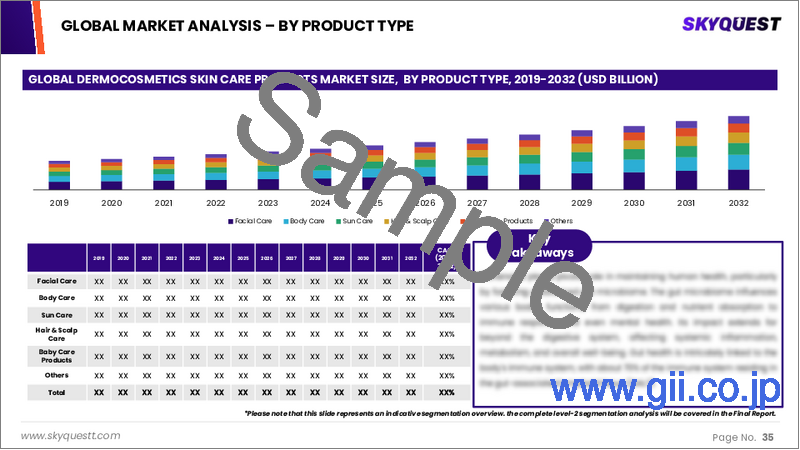|
|
市場調査レポート
商品コード
1633576
皮膚化粧品スキンケア製品の市場規模、シェア、成長分析:製品タイプ別、流通チャネル別、用途別、エンドユーザー別、 地域別 - 産業予測、2025年~2032年Dermocosmetics Skin Care Products Market Size, Share, Growth Analysis, By Type (Skin Care, Hair Care), By Distribution Channel (Supermarkets & Hypermarkets, Pharmacy & Drug Stores), By Application, By End User, By Region - Industry Forecast 2025-2032 |
||||||
|
|||||||
| 皮膚化粧品スキンケア製品の市場規模、シェア、成長分析:製品タイプ別、流通チャネル別、用途別、エンドユーザー別、 地域別 - 産業予測、2025年~2032年 |
|
出版日: 2025年01月11日
発行: SkyQuest
ページ情報: 英文 317 Pages
納期: 3~5営業日
|
全表示
- 概要
- 目次
皮膚化粧品スキンケア製品の世界市場規模は2023年に607億2,000万米ドルと評価され、2024年の652億7,000万米ドルから2032年には1,164億1,000万米ドルに成長し、予測期間中(2025-2032年)のCAGRは7.5%で成長する見通しです。
世界の皮膚化粧品スキンケア製品の市場は、化粧品としての魅力と治療上の利点を併せ持つ製品に対する消費者需要の高まりに後押しされ、力強い成長を遂げています。この成長は、パーソナルケアラインに含まれる合成化学物質に関連するリスクに対する意識の高まりによるところが大きいです。さらに、にきび、乾癬、湿疹などの皮膚疾患の罹患率が上昇していることも、市場拡大を後押ししています。消費者は、有害な成分を含まない製品を好み、自然でオーガニックなスキンケア解決策への傾倒を強めており、これが市場の成長をさらに加速させています。皮膚の健康と安全性の問題に対する意識が高まるにつれて、皮膚化粧品セクターは今後数年間で継続的な拡大を遂げ、スキンケア業界の主要企業としての地位を確立するものと思われます。
目次
イントロダクション
- 調査の目的
- 調査範囲
- 定義
調査手法
- 情報調達
- 二次データと一次データの方法
- 市場規模予測
- 市場の前提条件と制限
エグゼクティブサマリー
- 世界市場の見通し
- 供給と需要の動向分析
- セグメント別機会分析
市場力学と見通し
- 市場概要
- 市場規模
- 市場力学
- 促進要因と機会
- 抑制要因と課題
- ポーターの分析
主な市場の考察
- 重要成功要因
- 競合の程度
- 主な投資機会
- 市場エコシステム
- 市場の魅力指数(2024年)
- PESTEL分析
- マクロ経済指標
- バリューチェーン分析
- 価格分析
- 顧客と購買基準の分析
- 貿易分析
皮膚化粧品スキンケア製品市場規模:タイプ別& CAGR(2025-2032)
- 市場概要
- スキンケア
- アンチエイジング
- 肌の美白
- 日焼け止め
- ニキビ治療
- 湿疹治療
- その他
- ヘアケア
- 抜け毛防止
- フケ防止
- その他
皮膚化粧品スキンケア製品市場規模:流通チャネル別& CAGR(2025-2032)
- 市場概要
- スーパーマーケットとハイパーマーケット
- 薬局・ドラッグストア
- オンライン
- その他
皮膚化粧品スキンケア製品市場規模:用途別& CAGR(2025-2032)
- 市場概要
- アンチエイジング
- 保湿剤
- 血清
- その他
- 肌の明るさ
- クリーム&保湿剤
- クレンザー
- その他
- ヘア&スカルプケア
- シャンプー
- コンディショナー
- その他
- ベビーケア
- クリーム&保湿剤
- シャンプー
- マッサージオイル
- その他
- サンケア
- 大人用日焼け止め
- ベビーサンクリーム
- アフターサン
- その他
- ストレッチマーク防止
- クリーム
- 油
- リップケア
- リップクリーム
- リップスクラブ
- その他
- その他
皮膚化粧品スキンケア製品市場規模:エンドユーザー別& CAGR(2025-2032)
- 市場概要
- 男性
- 女性
皮膚化粧品スキンケア製品市場規模:地域別& CAGR(2025-2032)
- 北米
- 米国
- カナダ
- 欧州
- ドイツ
- スペイン
- フランス
- 英国
- イタリア
- その他欧州地域
- アジア太平洋地域
- 中国
- インド
- 日本
- 韓国
- その他アジア太平洋地域
- ラテンアメリカ
- ブラジル
- その他ラテンアメリカ地域
- 中東・アフリカ
- GCC諸国
- 南アフリカ
- その他中東・アフリカ
競合情報
- 上位5社の比較
- 主要企業の市場ポジショニング(2024年)
- 主な市場企業が採用した戦略
- 市場の最近の動向
- 企業の市場シェア分析(2024年)
- 主要企業の企業プロファイル
- 会社概要
- 製品ポートフォリオ分析
- セグメント別シェア分析
- 収益の前年比比較(2022-2024)
主要企業プロファイル
- L'Oreal S.A.(France)
- The Estee Lauder Companies Inc.(USA)
- Unilever PLC(United Kingdom)
- Beiersdorf AG(Germany)
- Shiseido Company, Limited(Japan)
- Procter & Gamble Co.(USA)
- Kao Corporation(Japan)
- Coty Inc.(USA)
- Amorepacific Corporation(South Korea)
- LG Household & Health Care Ltd.(South Korea)
- Johnson & Johnson(USA)
- Colgate-Palmolive Company(USA)
- L'Occitane International S.A.(Luxembourg)
- Pierre Fabre S.A.(France)
- Clarins S.A.(France)
- Oriflame Holding AG(Switzerland)
- Avon Products, Inc.(United Kingdom)
- Mary Kay Inc.(USA)
- Revlon, Inc.(USA)
- Ulta Beauty, Inc.(USA)
結論と推奨事項
Global Dermocosmetics Skin Care Products Market size was valued at USD 60.72 billion in 2023 and is poised to grow from USD 65.27 billion in 2024 to USD 116.41 billion by 2032, growing at a CAGR of 7.5% during the forecast period (2025-2032).
The global dermocosmetics skincare market is experiencing robust growth, fueled by heightened consumer demand for products that combine cosmetic appeal with therapeutic advantages. This growth is largely attributed to an increasing awareness of the risks associated with synthetic chemicals in personal care lines. Furthermore, the rising incidence of skin conditions like acne, psoriasis, and eczema is propelling market expansion. Consumers are increasingly inclined towards natural and organic skincare solutions, favoring products devoid of harmful ingredients, which further accelerates market growth. As awareness of skin health and safety issues rises, the dermocosmetics sector is poised for continued expansion in the coming years, positioning itself as a key player in the skincare industry.
Top-down and bottom-up approaches were used to estimate and validate the size of the Global Dermocosmetics Skin Care Products market and to estimate the size of various other dependent submarkets. The research methodology used to estimate the market size includes the following details: The key players in the market were identified through secondary research, and their market shares in the respective regions were determined through primary and secondary research. This entire procedure includes the study of the annual and financial reports of the top market players and extensive interviews for key insights from industry leaders such as CEOs, VPs, directors, and marketing executives. All percentage shares split, and breakdowns were determined using secondary sources and verified through Primary sources. All possible parameters that affect the markets covered in this research study have been accounted for, viewed in extensive detail, verified through primary research, and analyzed to get the final quantitative and qualitative data.
Global Dermocosmetics Skin Care Products Market Segmental Analysis
Global Dermocosmetics Skin Care Products Market is segmented by Type, Distribution Channel, Application, End User and region. Based on Type, the market is segmented into Skin Care and Hair Care. Based on Distribution Channel, the market is segmented into Supermarkets & Hypermarkets, Pharmacy & Drug Stores, Online and Others. Based on Application, the market is segmented into Anti-aging, Skin Brightening, Hair & Scalp Care, Baby Care, Sun Care, Anti-Stretch Mark, Lip Care and Others. Based on End User, the market is segmented into Male and Female. Based on region, the market is segmented into North America, Europe, Asia Pacific, Latin America and Middle East & Africa.
Driver of the Global Dermocosmetics Skin Care Products Market
The global dermocosmetics skin care products market is significantly driven by the rising consumer awareness regarding the importance of healthy skin. With the escalation of pollution, heightened stress levels, and evolving lifestyles, individuals are increasingly concerned about skin damage and aging. This heightened consciousness is propelling consumers to seek out dermocosmetic products designed to tackle specific skin concerns, including acne, pigmentation, and the appearance of fine lines. As people strive for flawless skin and seek effective solutions, the demand for specialized formulations in the dermocosmetics sector is expanding, thereby fostering market growth and innovation.
Restraints in the Global Dermocosmetics Skin Care Products Market
A significant challenge facing the global dermocosmetics skin care products market is the elevated pricing associated with these items. Due to their specialized formulations and the inclusion of active ingredients, dermocosmetics tend to be more expensive than conventional cosmetic products. This higher price point can deter potential consumers, particularly in developing nations where financial constraints are more pronounced. Furthermore, the limited availability of dermocosmetics, which are often sold through specific distribution channels such as pharmacies and specialized retail outlets, can further impede access for many individuals, making it difficult for them to purchase these products.
Market Trends of the Global Dermocosmetics Skin Care Products Market
The global dermocosmetics skin care products market is witnessing a significant shift towards the preference for natural and organic ingredients, driven by an increasingly health-conscious consumer base. As awareness of the potentially harmful effects of synthetic chemicals rises, shoppers are gravitating towards products devoid of harmful substances, favoring formulations enriched with plant extracts, essential oils, and herbal components. This trend reflects a broader movement towards sustainability and eco-friendliness, encouraging brands to innovate and reformulate their offerings to align with consumer values. Consequently, the demand for clean, green skincare solutions is anticipated to grow, reshaping the market dynamics considerably in the coming years.
Table of Contents
Introduction
- Objectives of the Study
- Scope of the Report
- Definitions
Research Methodology
- Information Procurement
- Secondary & Primary Data Methods
- Market Size Estimation
- Market Assumptions & Limitations
Executive Summary
- Global Market Outlook
- Supply & Demand Trend Analysis
- Segmental Opportunity Analysis
Market Dynamics & Outlook
- Market Overview
- Market Size
- Market Dynamics
- Drivers & Opportunities
- Restraints & Challenges
- Porters Analysis
- Competitive rivalry
- Threat of substitute
- Bargaining power of buyers
- Threat of new entrants
- Bargaining power of suppliers
Key Market Insights
- Key Success Factors
- Degree of Competition
- Top Investment Pockets
- Market Ecosystem
- Market Attractiveness Index, 2024
- PESTEL Analysis
- Macro-Economic Indicators
- Value Chain Analysis
- Pricing Analysis
- Customer & Buying Criteria Analysis
- Trade Analysis
Global Dermocosmetics Skin Care Products Market Size by Type & CAGR (2025-2032)
- Market Overview
- Skin Care
- Anti-Aging
- Skin Whitening
- Sun Protection
- Acne Treatment
- Eczema Treatment
- Others
- Hair Care
- Anti-Hairfall
- Anti-Dandruff
- Other
Global Dermocosmetics Skin Care Products Market Size by Distribution Channel & CAGR (2025-2032)
- Market Overview
- Supermarkets & Hypermarkets
- Pharmacy & Drug Stores
- Online
- Others
Global Dermocosmetics Skin Care Products Market Size by Application & CAGR (2025-2032)
- Market Overview
- Anti-aging
- Moisturizer
- Serum
- Others
- Skin Brightening
- Cream & Moisturizer
- Cleanser
- Others
- Hair & Scalp Care
- Shampoo
- Conditioner
- Others
- Baby Care
- Cream & Moisturizer
- Shampoo
- Massage Oil
- Others
- Sun Care
- Adult Sun Cream
- Baby Sun Cream
- After Sun
- Others
- Anti-Stretch Mark
- Cream
- Oil
- Lip Care
- Lip Balm
- Lip Scrub
- Others
- Others
Global Dermocosmetics Skin Care Products Market Size by End User & CAGR (2025-2032)
- Market Overview
- Male
- Female
Global Dermocosmetics Skin Care Products Market Size & CAGR (2025-2032)
- North America (Type, Distribution Channel, Application, End User)
- US
- Canada
- Europe (Type, Distribution Channel, Application, End User)
- Germany
- Spain
- France
- UK
- Italy
- Rest of Europe
- Asia Pacific (Type, Distribution Channel, Application, End User)
- China
- India
- Japan
- South Korea
- Rest of Asia-Pacific
- Latin America (Type, Distribution Channel, Application, End User)
- Brazil
- Rest of Latin America
- Middle East & Africa (Type, Distribution Channel, Application, End User)
- GCC Countries
- South Africa
- Rest of Middle East & Africa
Competitive Intelligence
- Top 5 Player Comparison
- Market Positioning of Key Players, 2024
- Strategies Adopted by Key Market Players
- Recent Developments in the Market
- Company Market Share Analysis, 2024
- Company Profiles of All Key Players
- Company Details
- Product Portfolio Analysis
- Company's Segmental Share Analysis
- Revenue Y-O-Y Comparison (2022-2024)
Key Company Profiles
- L'Oreal S.A. (France)
- Company Overview
- Business Segment Overview
- Financial Updates
- Key Developments
- The Estee Lauder Companies Inc. (USA)
- Company Overview
- Business Segment Overview
- Financial Updates
- Key Developments
- Unilever PLC (United Kingdom)
- Company Overview
- Business Segment Overview
- Financial Updates
- Key Developments
- Beiersdorf AG (Germany)
- Company Overview
- Business Segment Overview
- Financial Updates
- Key Developments
- Shiseido Company, Limited (Japan)
- Company Overview
- Business Segment Overview
- Financial Updates
- Key Developments
- Procter & Gamble Co. (USA)
- Company Overview
- Business Segment Overview
- Financial Updates
- Key Developments
- Kao Corporation (Japan)
- Company Overview
- Business Segment Overview
- Financial Updates
- Key Developments
- Coty Inc. (USA)
- Company Overview
- Business Segment Overview
- Financial Updates
- Key Developments
- Amorepacific Corporation (South Korea)
- Company Overview
- Business Segment Overview
- Financial Updates
- Key Developments
- LG Household & Health Care Ltd. (South Korea)
- Company Overview
- Business Segment Overview
- Financial Updates
- Key Developments
- Johnson & Johnson (USA)
- Company Overview
- Business Segment Overview
- Financial Updates
- Key Developments
- Colgate-Palmolive Company (USA)
- Company Overview
- Business Segment Overview
- Financial Updates
- Key Developments
- L'Occitane International S.A. (Luxembourg)
- Company Overview
- Business Segment Overview
- Financial Updates
- Key Developments
- Pierre Fabre S.A. (France)
- Company Overview
- Business Segment Overview
- Financial Updates
- Key Developments
- Clarins S.A. (France)
- Company Overview
- Business Segment Overview
- Financial Updates
- Key Developments
- Oriflame Holding AG (Switzerland)
- Company Overview
- Business Segment Overview
- Financial Updates
- Key Developments
- Avon Products, Inc. (United Kingdom)
- Company Overview
- Business Segment Overview
- Financial Updates
- Key Developments
- Mary Kay Inc. (USA)
- Company Overview
- Business Segment Overview
- Financial Updates
- Key Developments
- Revlon, Inc. (USA)
- Company Overview
- Business Segment Overview
- Financial Updates
- Key Developments
- Ulta Beauty, Inc. (USA)
- Company Overview
- Business Segment Overview
- Financial Updates
- Key Developments





